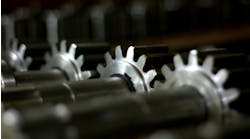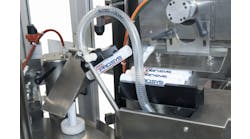Did you ever have someone “give you the shaft”? This insult is defined as ignoring or putting someone down. In gearing, giving you the shaft is just the beginning part of constructing your gear train. Each gear in a system is going to be resting on a shaft as the purpose of each gear is to transmit motion through the shafts of the mechanism.
Just as there are many types of gears, there are also many types of methods to attach a gear to a shaft.
Typically, when keys are used with gears, they're accompanied by set screws (also known as grub screws). The tapped holes to accommodate these screws are commonly positioned above the key slot and the second at 90 degrees to the key slot. This allows one set screw to hold the key in place and the other screw to press into the shaft.
However, a better solution is to have two tapped holes set at 120 degrees from the centerline of the key slot, as this balances the gear and reduces noise at higher speeds.
Although set screws and keys are the most common form of attaching a gear to a shaft, there are many other methods, and each of these methods makes sense depending on your application.
Press-Fit
Just as it sounds, it's possible to press a gear onto a shaft. If the tolerances between the bore of the gear and the diameter of the shaft are properly sized, (the bore is undersized, and the shaft is oversized) then you can use a press to force the gear onto the shaft and the resulting pressure will hold the gear in place. This method works best if you never need to remove the gear from the shaft and if you do not need to have a specific alignment between the gear teeth and the shaft.
Drill & Pin
This is one of many permanent methods of fixing the gear to the shaft. This method involves drilling a hole through the side of the hub, through the shaft, out through the opposite side of the hub, and then fixing a taper pin or a cotter pin into the hole. This method is infrequently used because it does not permit alignment, creates noise and vibration at high speeds, and will fail if the pin falls out.
Welding
It's possible to weld a gear to a shaft. This method is not very common because heating the gear and the shaft can result in distortions that will cause the gear to either be noisy or fail prematurely. It does, however, guarantee a strong bond between the gear and the shaft.
Shrink Fit
This method is preferable to both press-fitting and welding. In this method, you use an induction heater to warm the gear nearest to the bore and then you slide it onto the shaft. As the gear cools, the bore shrinks, and the bond between the gear and shaft is formed. This method works well when the gear needs to be repeatedly removed for maintenance, or for replacement, as it does not distort the gear teeth, nor does it warp or score the shaft.
Use of a Keyless Shaft-Hub Locking Mechanism
There are several styles of locking hubs that exist. Their primary purpose is to allow for the repeated repositioning of the gear and to prevent any damage to the shaft during installation or removal. Thus, they perform the same action of a shrink fit, but they use mechanical means instead of heat.
One such style uses two hubs in which the inside hub presses against the shaft when the screws are tightened, and the outside hub presses against the bore. Together these two hubs force equal pressure on the bore and shaft and hold the gear in place.
What's great about this style of mechanism is that it allows for infinite positioning of the gear teeth in relation to the shaft. The downside is that they add mass to the mechanism and require additional space for installation.
Concentric Maxi Torque Keyless Shaft-Hub Mechanism
Another style integrates a locking mechanism directly into the bore of a gear. This style is marketed as the Concentric Maxi Torque keyless shaft hub mechanism. It combines a proprietary hub with a tapered insert. As a set screw is tightened between the insert and the hub, the mechanism presses on both the bore and the shaft, generating the necessary holding force. This item is also excellent for repositioning, and neither mars the shaft nor does it take additional space.
Integrated Locking Mechanism
A third style integrates a locking mechanism into the hub of a gear. This style uses two intersecting slots in the gear hub to generate a wedge section. The wedge is closed by a cap screw, which forces the free section of the hub to clamp onto the shaft. This mechanism is excellent for repositioning but is limited by the holding strength of the wedge.
These are some of the many ways that you can fix a gear to a shaft. Each has its pros and cons, both mechanically as well as cost.
Hopefully, the next time someone hands you a shaft, it's for assembling a gear mechanism and they're not “giving you the shaft.”









